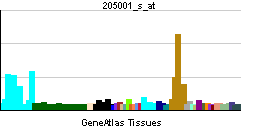DDX3Y
| DEAD (Asp-Glu-Ala-Asp) box polypeptide 3, Y-linked | |||||||||||||
|---|---|---|---|---|---|---|---|---|---|---|---|---|---|
 PDB rendering based on 2i4i. | |||||||||||||
| |||||||||||||
| Identifiers | |||||||||||||
| Symbols | DDX3Y ; DBY | ||||||||||||
| External IDs | Template:OMIM5 Template:MGI HomoloGene: 55839 | ||||||||||||
| |||||||||||||
| RNA expression pattern | |||||||||||||
 | |||||||||||||
 | |||||||||||||
| More reference expression data | |||||||||||||
| Orthologs | |||||||||||||
| Template:GNF Ortholog box | |||||||||||||
| Species | Human | Mouse | |||||||||||
| Entrez | n/a | n/a | |||||||||||
| Ensembl | n/a | n/a | |||||||||||
| UniProt | n/a | n/a | |||||||||||
| RefSeq (mRNA) | n/a | n/a | |||||||||||
| RefSeq (protein) | n/a | n/a | |||||||||||
| Location (UCSC) | n/a | n/a | |||||||||||
| PubMed search | n/a | n/a | |||||||||||
DEAD (Asp-Glu-Ala-Asp) box polypeptide 3, Y-linked, also known as DDX3Y, is a human gene.[1]
DEAD box proteins, characterized by the conserved motif Asp-Glu-Ala-Asp (DEAD), are putative RNA helicases. They are implicated in a number of cellular processes involving alteration of RNA secondary structure such as translation initiation, nuclear and mitochondrial splicing, and ribosome and spliceosome assembly. Based on their distribution patterns, some members of this family are believed to be involved in embryogenesis, spermatogenesis, and cellular growth and division. This gene encodes a DEAD box protein, and it has a homolog on the X chromosome. The gene mutation causes male infertility, Sertoli cell-only syndrome or severe hypospermatogenesis, suggesting that this gene plays a key role in the spermatogenic process. Alternative splicing of this gene generates 2 transcripts, which differ only in the length of the 3' UTR.[1]
References
Further reading
- Lahn BT, Page DC (1997). "Functional coherence of the human Y chromosome". Science. 278 (5338): 675–80. PMID 9381176.
- Foresta C, Ferlin A, Moro E (2000). "Deletion and expression analysis of AZFa genes on the human Y chromosome revealed a major role for DBY in male infertility". Hum. Mol. Genet. 9 (8): 1161–9. PMID 10767340.
- Shen P, Wang F, Underhill PA; et al. (2000). "Population genetic implications from sequence variation in four Y chromosome genes". Proc. Natl. Acad. Sci. U.S.A. 97 (13): 7354–9. PMID 10861003.
- Session DR, Lee GS, Wolgemuth DJ (2001). "Characterization of D1Pas1, a mouse autosomal homologue of the human AZFa region DBY, as a nuclear protein in spermatogenic cells". Fertil. Steril. 76 (4): 804–11. PMID 11591417.
- Kim YS, Lee SG, Park SH, Song K (2002). "Gene structure of the human DDX3 and chromosome mapping of its related sequences". Mol. Cells. 12 (2): 209–14. PMID 11710523.
- Vogt MH, van den Muijsenberg JW, Goulmy E; et al. (2002). "The DBY gene codes for an HLA-DQ5-restricted human male-specific minor histocompatibility antigen involved in graft-versus-host disease". Blood. 99 (8): 3027–32. PMID 11929796.
- Strausberg RL, Feingold EA, Grouse LH; et al. (2003). "Generation and initial analysis of more than 15,000 full-length human and mouse cDNA sequences". Proc. Natl. Acad. Sci. U.S.A. 99 (26): 16899–903. doi:10.1073/pnas.242603899. PMID 12477932.
- Skaletsky H, Kuroda-Kawaguchi T, Minx PJ; et al. (2003). "The male-specific region of the human Y chromosome is a mosaic of discrete sequence classes". Nature. 423 (6942): 825–37. doi:10.1038/nature01722. PMID 12815422.
- Zorn E, Miklos DB, Floyd BH; et al. (2004). "Minor histocompatibility antigen DBY elicits a coordinated B and T cell response after allogeneic stem cell transplantation". J. Exp. Med. 199 (8): 1133–42. doi:10.1084/jem.20031560. PMID 15096539.
- Brill LM, Salomon AR, Ficarro SB; et al. (2004). "Robust phosphoproteomic profiling of tyrosine phosphorylation sites from human T cells using immobilized metal affinity chromatography and tandem mass spectrometry". Anal. Chem. 76 (10): 2763–72. doi:10.1021/ac035352d. PMID 15144186.
- Ditton HJ, Zimmer J, Kamp C; et al. (2005). "The AZFa gene DBY (DDX3Y) is widely transcribed but the protein is limited to the male germ cells by translation control". Hum. Mol. Genet. 13 (19): 2333–41. doi:10.1093/hmg/ddh240. PMID 15294876.
- Sekiguchi T, Iida H, Fukumura J, Nishimoto T (2004). "Human DDX3Y, the Y-encoded isoform of RNA helicase DDX3, rescues a hamster temperature-sensitive ET24 mutant cell line with a DDX3X mutation". Exp. Cell Res. 300 (1): 213–22. doi:10.1016/j.yexcr.2004.07.005. PMID 15383328.
- Gerhard DS, Wagner L, Feingold EA; et al. (2004). "The status, quality, and expansion of the NIH full-length cDNA project: the Mammalian Gene Collection (MGC)". Genome Res. 14 (10B): 2121–7. doi:10.1101/gr.2596504. PMID 15489334.
- Ficarro SB, Salomon AR, Brill LM; et al. (2005). "Automated immobilized metal affinity chromatography/nano-liquid chromatography/electrospray ionization mass spectrometry platform for profiling protein phosphorylation sites". Rapid Commun. Mass Spectrom. 19 (1): 57–71. doi:10.1002/rcm.1746. PMID 15570572.
- Rush J, Moritz A, Lee KA; et al. (2005). "Immunoaffinity profiling of tyrosine phosphorylation in cancer cells". Nat. Biotechnol. 23 (1): 94–101. doi:10.1038/nbt1046. PMID 15592455.
- Pope SN, Lee IR (2005). "Yeast two-hybrid identification of prostatic proteins interacting with human sex hormone-binding globulin". J. Steroid Biochem. Mol. Biol. 94 (1–3): 203–8. doi:10.1016/j.jsbmb.2005.01.007. PMID 15862967.
| This protein-related article is a stub. You can help Wikipedia by expanding it. |